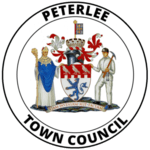"an architecture and sculpture of purely abstract form through which to walk, in which to linger and on which to play, a free and anonymous monument which, because of it’s independence, can lift the activity and psychology of an urban housing community on to a universal plane”

The idea for the Apollo Pavilion was the culmination of Victor Pasmore's involvement with the planning and design of the new town of Peterlee in County Durham which began in 1954 with his appointment by A.V. Williams, the General Manager, as a consultant architectural designer to the Corporation. The brief was to inject a new initiative into the new town's design, which had been limited by practical and financial constraints. The early departure of Berthold Lubetkin from the original design team, and the limitations imposed by building on land subject to underground mining, had led to a deterioration in the quality of the architecture being produced at Peterlee.
Victor Pasmore (1908-1998) was an extremely influential artist and became one of the leading abstract artists of his day. His work is found in collections around the world including Tate Britain, MoMA New York and the Art Gallery of South Australia. His style developed from Figurative to Abstract after World War II, and at the time of his involvement with Peterlee he was Master of Painting at King's College, Durham University (later Newcastle University). He was appointed CBE in 1959, a Companion of Honour in 1981 and a Royal Academician in 1983.
Pasmore was known to be interested in town planning and had participated in the International Congress of Modern Architecture. He had produced two murals in collaboration with architects. At Peterlee Pasmore worked initially alongside architects Peter Daniel and Franc Dixon to develop the Sunny Blunts estate in the south-west area of the town, though by the time the Pavilion was built Dixon had left and the team included the more experienced Harry Durell, Colin Gardham and landscape architect David Thirkettle. Pasmore continued to be involved with Peterlee until 1978 and designed the Pavilion as a gift to the town.
Pasmore began designs for the Pavilion in 1963 and it was completed in 1969. It was the centre piece of a wider landscape which involved the damming of a small beck to form a lake which the Pavilion bridges at its eastern end. The Pavilion and lake together formed a focus for the Sunny Blunts housing area and linked the areas on each side of the watercourse. This landscape was included in the English Heritage Register of Historic Parks and Gardens in 2002. The Pavilion suffered from grafitti and some vandalism from the late 1970s, and in the mid/late 1980s steps on the north and south sides to the upper level were removed. The two original murals faded until they were almost indistinguishable.
It was restored in 2009 with the help of a Heritage Lottery Grant of £336,000. The restoration restored the south side stairway (the other had not been part of the original design), reset the cobbles in the surrounding area and reinstated the two murals on the north and south walls. A metal gate restricting access at night time to the upper level has been introduced, and the original lighting scheme, out of action since the mid 1970s, has been reinstated.
Today the Pavilion continues to split opinion...like Marmite, people tend to either love it or hate it! Why not come along and make your own mind up?
